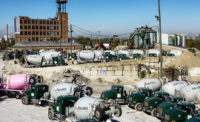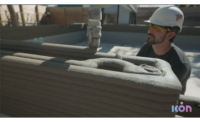Ready-mix concrete producers have long resisted adopting digitized delivery and verification processes, mostly due to regional producers coping with different rules and varying customer demands across so many jurisdictions. But logistical issues related to the COVID-19 pandemic are eroding that reticence.
“Producers are super interested in getting rid of paper right now,” says Tim Oakes, president of Digital Fleet, maker of a cloud-based app that lets ready-mix companies manage their barrel truck fleets. “That’s the biggest thing that we’ve seen. Prior to COVID-19 it was a long-term desire to cut down on waste. Now they say, ‘We gotta get rid of that [paper] now.’ ”
Mobile apps such as Digital Fleet, WheresMyConcrete and TRUCKAST are all working with producers to streamline ticketing, batching and delivery of concrete. The applications are also being used to record data captured by sensors on temperature, slump and other metrics to ensure proper curing.
“We went from a system where checks were mandated by someone physically signing off to one similar to how UPS delivers packages, where a notification is automatically sent when a truck leaves the plant, when it stops and when it delivers its load,” says Brandon Luchene, information systems director at BARD Materials in Dubuque, Iowa. His company has worked with Digital Fleet to go paperless.
“Paper and human contacts were not the essential part of the checks and balances of delivering materials properly,” Luchene says. He explains that a record of the slump, drum rotations, and water added to the concrete is available when it leaves the batch plant, while it is in the truck and when it arrives at the site, all thanks to sensors and Digital Fleet’s in-cab app. BARD’s system generates an e-ticket for each delivery with all of the relevant information attached.
|
Related Link |
BARD serves parts of Iowa, Illinois and Wisconsin and works with all three states’ departments of transportation. The company has endeavored to go digital for more than five years, but “in the past nine months it has become a priority for everyone,” Luchene says. “The pandemic has forced new safety measures and aligned our priorities with our customers. As a result we are safer and more efficient with electronic, contactless ticketing.”
In addition to working with Digital Fleet on its ticketing, BARD is in the planning stages of a system that will allow it to upload its batched ticket data in real time to the Iowa DOT via an API connected to Iowa DOT’s Command Alkon Connex system. For the sensors, BARD is using CiDRA’s SMARThatch on its trucks’ mixing drums to provide continuous monitoring of air entrainment, temperature and hydraulic pressure from the batch plant to the site.
“We’re still very early, but with the truck sensors we’re piloting new hardware,” Luchene says. “This real-time data helps us make quality decisions before a truck even makes it to the jobsite.”
While technology such as SMARThatch shows promise, forensic engineers warn that the reason concrete has historically been difficult to measure properly with sensors is in its very nature as a material.
“There have been many sensors over the years that have attempted to estimate slump and consistency, and they don’t necessarily measure slump itself,” says Todd Nelson, associate principal at Wiss, Janney, Elstner Associates in Northbook, Ill.
Nelson says the technology used by the ready-mix industry had previously measured the torque resistance of the drum mixer and not the slump, which was a problem.
“Estimating slump has to be calibrated to the specific mix. Changes in the constituent raw materials are going to have an impact,” he says.
Nelson says that adopting electronic ticketing, a technology other industries have had for more than 20 years, is a step forward for concrete producers, as it can capture more comprehensive temperature data.
“From a quality control perspective and a forensic perspective, knowing concrete temperature from batch to placement is important,” he says. “Having that information would help inform the contractor, the independent testing lab on site and, eventually, those of us in forensic investigation.”





---Urban-Mining-Industries-Pozzotive_ENRready.jpg?height=200&t=1663257031&width=200)

Post a comment to this article
Report Abusive Comment